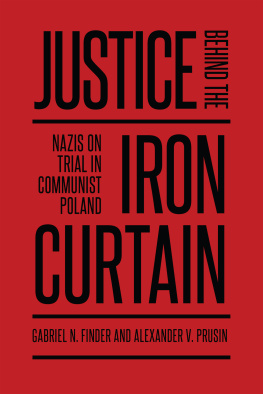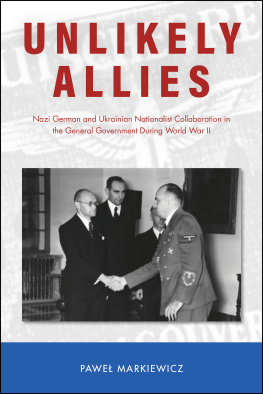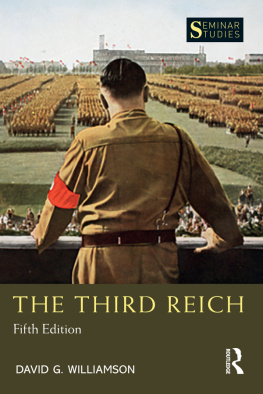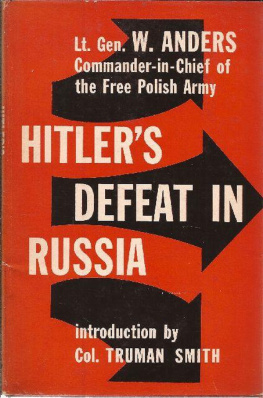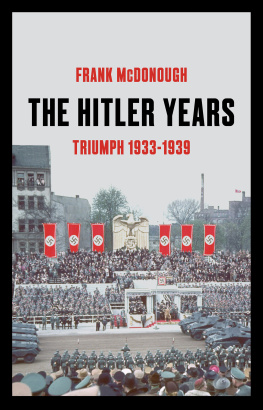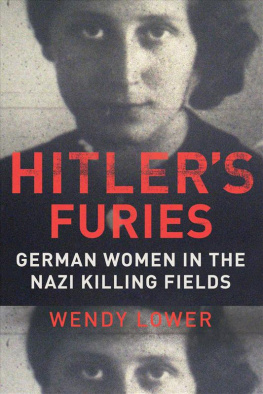Martin Winstone is an Education Officer for the Holocaust Educational Trust. He is the author of The Holocaust Sites of Europe: An Historical Guide (I.B.Tauris).
THE DARK HEART
of
HITLERS EUROPE
Nazi Rule in Poland under the General Government
MARTIN WINSTONE

Published in 2015 by I.B.Tauris & Co. Ltd
6 Salem Road, London W2 4BU
175 Fifth Avenue, New York NY 10010
www.ibtauris.com
Distributed in the United States and Canada Exclusively by Palgrave Macmillan
175 Fifth Avenue, New York NY 10010
Copyright 2015 Martin Winstone
The right of Martin Winstone to be identified as the author of this work has been asserted by the author in accordance with the Copyright, Designs and Patents Act 1988.
All rights reserved. Except for brief quotations in a review, this book, or any part thereof, may not be reproduced, stored in or introduced into a retrieval system, or transmitted, in any form or by any means, electronic, mechanical, photocopying, recording or otherwise, without the prior written permission of the publisher.
Every attempt has been made to gain permission for the use of the images in this book. Any omissions will be rectified in future editions.
ISBN: 978 1 78076 477 1
eISBN: 978 0 85773 500 3
A full CIP record for this book is available from the British Library
A full CIP record is available from the Library of Congress
Library of Congress Catalog Card Number: available
Contents
Illustrations
Maps
Plates
Rivals in crime: Heinrich Himmler and Hans Frank. (United States Holocaust Memorial Museum, courtesy of Muzeum Historii Fotografii Krakowskiego Towarzystwa Fotograficznego)
Odilo Globocnik. ( United States Holocaust Memorial Museum, courtesy of Geoffrey Giles)
Women are led to their execution at Palmiry. ( Narodowe Archiwum Cyfrowe)
Krakws Jews are forced into the ghetto, March 1941. (United States Holocaust Memorial Museum, courtesy of Archiwum Pastwowe w Krakowie)
Ukrainian nationalists greet Frank in Lww, August 1941. ( Narodowe Archiwum Cyfrowe)
Soviet prisoners of war in the Dblin camp. (United States Holocaust Memorial Museum, courtesy of National Archives and Records Administration, College Park)
German troops in Warsaw guard Poles seized for labour deportation to the Reich. ( Narodowe Archiwum Cyfrowe)
A street in the Warsaw ghetto. ( United States Holocaust Memorial Museum, courtesy of Guenther Schwarberg)
Making Krakw free of Jews: a deportation train, probably to Beec. (United States Holocaust Memorial Museum, courtesy of Archiwum Dokumentacji Mechanicznej)
Paszw forced labour camp. ( The Wiener Library)
Such a beautiful young girl, so innocent: Czesawa Kwoka. ( Pastwowe Muzeum Auschwitz-Birkenau w Owicimiu)
Children are separated from their parents during the Zamo Aktion. ( Narodowe Archiwum Cyfrowe)
An underground bunker is discovered during the Warsaw Ghetto Uprising. (United States Holocaust Memorial Museum, courtesy of National Archives and Records Administration, College Park)
Home Army troops with a captured German tank during the Warsaw Uprising. ( United States Holocaust Memorial Museum, courtesy of Juliusz Bogdan Deczkowski)
Frank in his cell at Nuremberg. (United States Holocaust Memorial Museum, courtesy of National Archives and Records Administration, College Park)
Warsaw in 1945. The area of the ghetto is in the foreground. ( United States Holocaust Memorial Museum, courtesy of Juliusz Bogdan Deczkowski)
The views or opinions expressed in this book, and the context in which the images are used, do not necessarily reflect the views or policy of, nor imply approval or endorsement by, the United States Holocaust Memorial Museum.
Acknowledgements
I would first like to thank all at I.B.Tauris who have been involved in the genesis of this book, in particular Joanna Godfrey who has supported it from the beginning and been a source of essential advice. Thanks too to David Campbell and Wendy Toole for ensuring a painless editorial process.
Especial gratitude is also due to Jane Caplan, for so kindly sharing her time and insights when we discovered a common interest in Baedekers Generalgouvernement, and to Rainer Eisenschmid, editor-in-chief of Baedeker, who proved an extremely generous source of indispensable information. I have also benefited immensely from the interest and thoughts of Dieter Pohl, Philippe Sands and Simon Constantine.
I also wish to think the many individuals and institutions who provided essential help along the way, including the staff of the Wiener Library, especially Kat Hbschmann and Marek Jaros, the staff of the Bodleian Library and the National Archives, Wojciech Posa of the Auschwitz-Birkenau State Museum, Caroline Waddell of the United States Holocaust Memorial Museum, Renata Balewska of the Narodowe Archiwum Cyfrowe, and Marcela Krukowksa.
Karen Pollock, Alex Maws and all of my colleagues at the Holocaust Educational Trust could not have provided a more stimulating working environment whilst the Holocaust survivors with whom we work, some of whom lived through the horrors described in this book, have been an inspiration. My parents have, as always, provided unstinting love and support.
My greatest debt of gratitude is owed to my partner Elizabeth Burns and to my daughter Sarah for their love, encouragement and forbearance. Their support and companionship have been a constant inspiration during the creation of this book, which is dedicated to them with love.
Abbreviations
AK | Home Army |
BCh | Peasant Battalions |
DG IV | Durchgangsstrae IV |
GL | Peoples Guard |
HSSPF | Higher SS and Police Leader |
IdO | Institut fr deutsche Ostarbeit |
KWC | Directorate of Civil Resistance |
NSDAP | National Socialist (Nazi) German Workers Party |
NSZ | National Armed Forces |
Orpo | Order Police |
OUN | Organization of Ukrainian Nationalists |
PKWN | Polish Committee of National Liberation |
PPR | Polish Workers Party |
PPS | Polish Socialist Party |
RGO | Main Welfare Council |
RKFDV | Reichskommissar for the Strengthening of Germandom |
Sipo | Security Police |
SL | Peoples Party |
SN | National Party |
SSPF | SS and Police Leader |
SZP | Polish Victory Service |
UPA | Ukrainian Insurgent Army |
UTsK | Ukrainian Central Committee |
OB | Jewish Combat Organization |
ZWZ | Union of Armed Struggle |
Notes on place names and sources
As a general rule, Polish names have been used for locations within the General Government and other territories of the prewar Polish state; thus Lww, for example, rather than Lviv or Lemberg. This is not intended to assert any contemporary political claims but rather to indicate that these sites were legally Polish territory in 1939. The only exceptions are the use of Warsaw and Vistula rather than Warszawa and Wisa, given their near universal usage in the English-speaking world, and the designation of the Nazi concentration camp complex in the Polish town of Owicim by its German name of Auschwitz-Birkenau.
Next page

